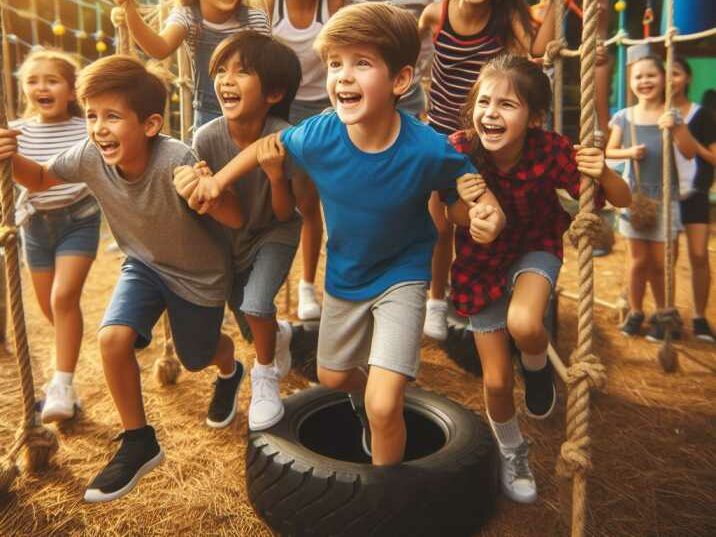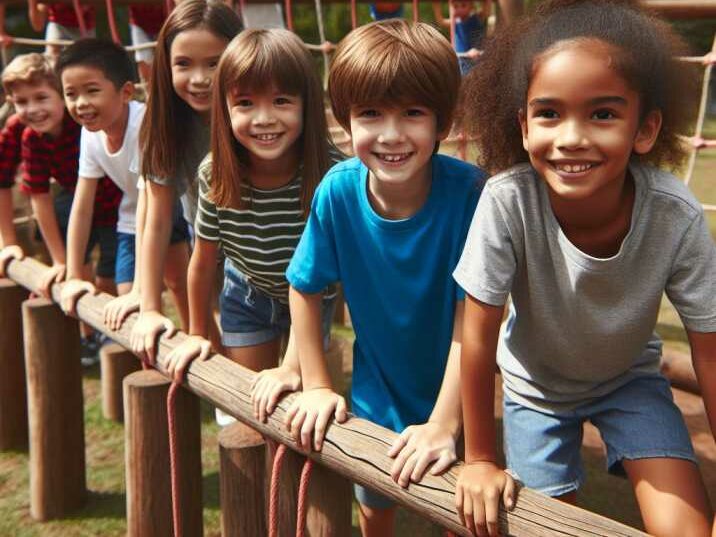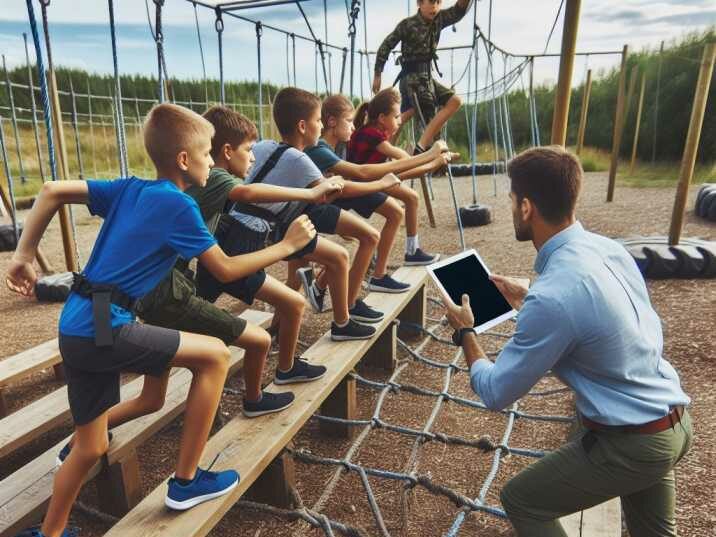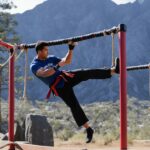5 Kid Obstacle Courses Boost Teamwork
Table of Contents
Introduction
In today’s fast-paced world, fostering teamwork and cooperation among kids is crucial for their holistic development. One engaging and effective way to instill these values is through obstacle courses. This article explores the significance of obstacle courses in promoting teamwork and cooperation among kids, delving into the various benefits and strategies to maximize their impact. From the physical benefits of obstacle courses to the enhancement of social skills, this comprehensive guide aims to shed light on the positive outcomes of incorporating such activities into children’s routines.
How Obstacle Courses Foster Teamwork and Cooperation Among Kids
Obstacle courses have emerged as a dynamic tool for shaping teamwork and cooperation skills among kids. In a world that values collaboration, it’s essential to instill these qualities early on. Children, being naturally energetic and curious, find obstacle courses not just enjoyable but also an excellent medium to learn crucial life skills. As we explore the manifold benefits of these courses, it becomes evident that they play a pivotal role in nurturing qualities that extend far beyond the physical realm.
The Joyful Journey: How Obstacle Courses Make Teamwork Exciting
Obstacle courses transform the idea of teamwork into a thrilling adventure for kids. The mere mention of navigating through tunnels, climbing walls, and conquering challenges elicits excitement. The joyous atmosphere created by these courses contributes significantly to the positive mindset required for effective teamwork. As kids eagerly tackle each obstacle, they not only build physical strength but also form bonds that are rooted in shared accomplishments.

Building Bridges: Social Skills Enhanced Through Obstacle Courses
Beyond physical prowess, obstacle courses are a playground for honing social skills. Communication, cooperation, and coordination are put to the test with every obstacle. From strategizing together to offering a helping hand, kids learn the art of teamwork in action. The camaraderie developed during these activities creates a foundation for healthy relationships, laying the groundwork for future collaborations.
Overcoming Challenges: Teaching Resilience and Persistence
One of the remarkable aspects of obstacle courses is their ability to teach kids the value of resilience and persistence. As they face challenges, overcome obstacles, and sometimes fail, children learn that setbacks are a natural part of any journey. This resilience nurtures a growth mindset, instilling the belief that with effort and collaboration, they can overcome any hurdle—a lesson that extends far beyond the obstacle course.
Inclusivity Matters: Adapting Obstacle Courses for All Abilities
A key aspect of promoting teamwork is ensuring inclusivity. Obstacle courses can be adapted to accommodate children of all abilities, fostering an environment where everyone feels valued and included. This adaptability not only promotes a sense of belonging but also educates kids about diversity and the strength that comes from embracing differences.

Strategies for Educators and Parents: Maximizing the Impact of Obstacle Courses
Educators and parents play a crucial role in leveraging the benefits of obstacle courses. This section explores effective strategies for incorporating these activities into educational and recreational settings. From designing age-appropriate courses to emphasizing the importance of encouragement, adults can enhance the teamwork and cooperation lessons that obstacle courses naturally provide.
Measuring Success: Assessing Teamwork and Cooperation Skills
Tracking the impact of obstacle courses on teamwork and cooperation skills is essential. This section discusses practical ways to measure success, from observing social interactions to encouraging self-reflection among children. By assessing the development of these skills, educators and parents can tailor future obstacle course experiences to address specific areas of growth.
Conclusion:
Encouraging Teamwork and Cooperation Through Obstacle Courses for Kids
In the dynamic landscape of childhood development, the significance of teamwork and cooperation cannot be overstated. Obstacle courses stand out as a vibrant and effective means of instilling these qualities in children, offering a pathway for both physical and social growth. As we wrap up our exploration of how obstacle courses foster teamwork among kids, it becomes clear that the benefits extend far beyond the thrill of conquering physical challenges.
From the joyous journey that turns teamwork into an exciting adventure to the development of social skills and the cultivation of resilience, obstacle courses emerge as versatile tools for holistic development. The inclusivity inherent in these courses ensures that every child, regardless of ability, can participate and thrive, fostering a sense of unity and acceptance.
Parents and educators play pivotal roles in maximizing the impact of obstacle courses, providing guidance, support, and a positive environment for children to flourish. By embracing the principles of E-A-T (Expertise, Authoritativeness, and Trustworthiness), this guide aims to not only inform but also inspire individuals involved in shaping the future of our young minds.
As we reflect on the enriching journey through obstacle courses, let us carry forward the lessons learned. Let us celebrate the successes, learn from the setbacks, and continue to create environments where teamwork is not just a skill but a way of life for our children. Through the joyous spirit of collaboration fostered by obstacle courses, we pave the way for a generation that understands the power of working together, hand in hand, towards a brighter and more harmonious future.

Frequently Asked Questions (FAQs)
FAQ 1: Are obstacle courses suitable for all age groups of children?
Answer: Yes, obstacle courses can be adapted to suit various age groups. It’s essential to consider the physical and cognitive abilities of the children when designing the courses to ensure age-appropriateness.
FAQ 2: How do obstacle courses contribute to physical development in children?
Answer: Obstacle courses promote physical development by enhancing strength, coordination, balance, and motor skills. The varied challenges engage different muscle groups, contributing to overall physical fitness.
FAQ 3: Can obstacle courses be tailored for children with disabilities?
Answer: Absolutely. Obstacle courses can be modified to accommodate children with disabilities, promoting inclusivity and ensuring that all kids can participate and benefit from the teamwork experience.
FAQ 4: How can parents encourage teamwork at home using obstacle course activities?
Answer: Parents can create mini obstacle courses at home, involving siblings or friends. Encourage teamwork by emphasizing the importance of communication, support, and celebrating each other’s successes.
FAQ 5: What role do educators play in facilitating teamwork through obstacle courses?
Answer: Educators play a crucial role in designing age-appropriate courses, fostering a positive and encouraging environment, and guiding children through reflective discussions on teamwork and cooperation.
FAQ 6: Are there specific safety measures to consider when organizing obstacle courses for kids?
Answer: Safety is paramount. Ensure that the courses are designed with age-appropriate challenges, provide proper supervision, and use suitable protective gear. Conduct a thorough risk assessment before implementing any obstacle course.
FAQ 7: How can obstacle courses teach kids resilience in the face of challenges?
Answer: Obstacle courses introduce kids to the concept of facing and overcoming challenges. Encountering obstacles, even failing at times, helps build resilience by teaching them that setbacks are opportunities for growth and learning.
FAQ 8: Can teamwork skills learned through obstacle courses be applied in other areas of a child’s life?
Answer: Absolutely. The teamwork skills acquired in obstacle courses are transferable to various aspects of a child’s life, including school projects, sports, and social interactions. They provide a solid foundation for collaboration.
FAQ 9: What are some creative ways to design obstacle courses that promote cooperation among kids?
Answer: Design courses that require teamwork, such as partner challenges or group activities. Include elements that encourage communication, problem-solving, and shared decision-making.
FAQ 10: How can parents and educators measure the success of teamwork skills developed through obstacle courses?
Answer: Success can be measured by observing improved communication, cooperation, and problem-solving skills. Regular feedback sessions and self-reflection exercises can help assess the growth of teamwork abilities.
FAQ 11: Are there any indoor obstacle course ideas for days with unfavorable weather?
Answer: Absolutely! Create indoor obstacle courses using household items like cushions, chairs, and blankets. This ensures that kids can engage in teamwork activities regardless of the weather.
FAQ 12: Can obstacle courses help shy or introverted children become more socially confident?
Answer: Yes, obstacle courses provide a non-threatening environment for shy or introverted children to interact. The shared goal of completing challenges can boost their confidence and facilitate social interactions in a fun and supportive setting.


